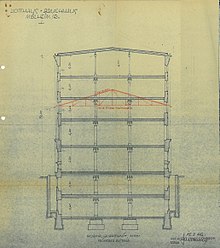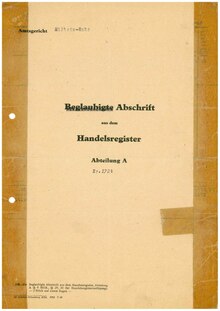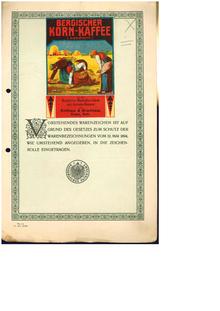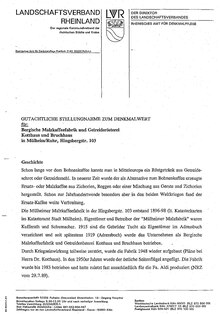Old malt factory
The Alte Malzfabrik in Mülheim an der Ruhr is a former factory for the industrial production of malt products, especially malt coffee. On November 18, 2003, the factory was placed under protection as a monument .
Industrial monument
In 1896 the original plans for the Mülheimer malt factory “Kufferath und Schels” at Hingbergstraße 103 in Mülheim an der Ruhr , located directly on the Mülheim-Essen railway line, were made. This malt factory was not the only one on the Hingberg in Mülheim. Further towards the city center there was the Schroer malt factory, which existed until 1990. Another malt factory was also in the lower Hingberg in a backyard location. The factories in Mülheim close to the city are almost all destroyed or demolished today. Only the "Alte Malzfabrik" still exists and gives an authentic impression of the former situation in Mülheim, which was characterized by numerous factories in the immediate city center.
Industrial use
Shortly after planning in 1898, the factory was built and the production of malt coffee started and grain roasted. The owners and operators of the "Mülheimer Malzfabrik" were Kufferath and Schels. Dresdner Bank AG, Berlin had been the owner since 1908. From 1908 to 1911 the factory was sold to the merchant Herm. Kufferath, then leased from March 1, 1913 to the Tucht brothers, Hagen / Westphalia. With a notary contract dated January 28, 1918, the open trading company "Bergische Malzkaffee - Factory and Grain Roasting Kotthaus & Bruchhaus" acquired the factory building from Dresdner Bank AG for a purchase price of RM 170,000 and started operations on March 1, 1918.
The malt factory underwent a fundamental renovation in 1943. It was equipped with new technical equipment under the name Bergische Malzkaffeefabrik . Production continued until well into the Second World War. It was not until a bomb hit on the night of June 23, 1943 that the main building was largely destroyed and operations were interrupted.
An auxiliary building served as a temporary production facility. After the war, the reconstruction took place quickly. The construction company Hochtief largely restored the building, albeit two storeys lower, according to the plans of the Cologne architect Ernst Gondrom, and production to supply the post-war population was resumed. For several years goods were manufactured and sold under the company names Kotthaus and Bruchhaus . Finally, production was stopped. The buildings were still used, u. a. as a granary until commercial use was finally given up in 1991. After that the factory stood empty.
Monument protection
In 1995 , the Rhineland Regional Association prepared an expert opinion on the monument value of the old malt factory as part of the protection process:
“The Kotthaus and Bruchhaus malt factory is a good example of the castle style that has dominated industrial architecture in all sectors since around 1860. Malt factories as well as breweries with their towers were particularly suitable for this style of castles, which in mining had its parallel in the Malakow towers, which were built until around 1880 . The castle style in the factory architecture marked a specific social and societal understanding in the industrial bourgeoisie, which in the second half of the 19th century tended to a "new feudality" and in many ways imitated the nobility of the declining Wilhelmine feudal state. Connected to the Malakow towers of the mining industry, the Kotthaus and Bruchhaus malt factory is an unmistakable aspect of the architecture of the Ruhr area. In the differentiation of the building with the kiln-topped Darrenhaus in the center, the property also embodies the technology of malt coffee production before the gas and coke-heated roasting ovens prevailed. The preserved office equipment is also interesting in terms of industrial history.
For the reasons mentioned, the Kotthaus and Bruchhaus malt factory is important for human history and for the development of working and production conditions. "
Continued use
In 1997 a private citizen bought the malt factory. He intended to use them for a new urban development use as living space loft apartments . In addition, a museum should be set up. The old machine parts were removed from the premises and the entire interior was gutted and renovated. The outer facade was restored and brought into a timely state by means of suitable windows. The two originally existing upper floors, which were destroyed in the Second World War, were also rebuilt. The architect and monument protection department have replaced the original gable roof with a barrel roof spanning the entire building in order to achieve a clear distinction between the historical and the new structure.
Web links
Individual evidence
- ↑ Alte Malzfabrik Kotthaus & Bruchhaus at muelheim-ruhr.de/baudenkmal accessed on March 3, 2013.
Coordinates: 51 ° 25 ′ 54 ″ N , 6 ° 53 ′ 42.2 ″ E





